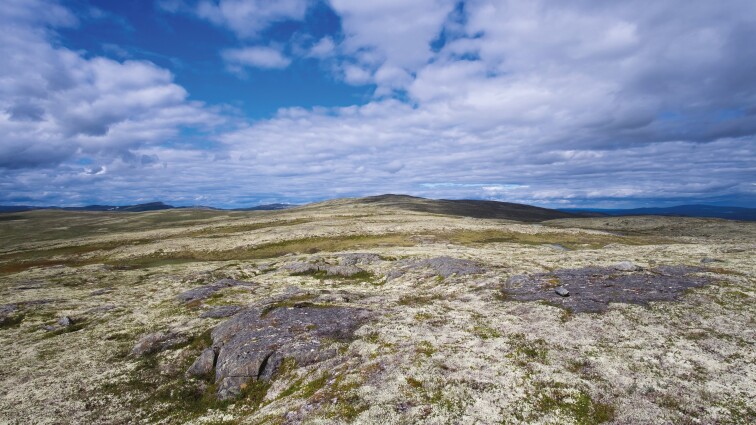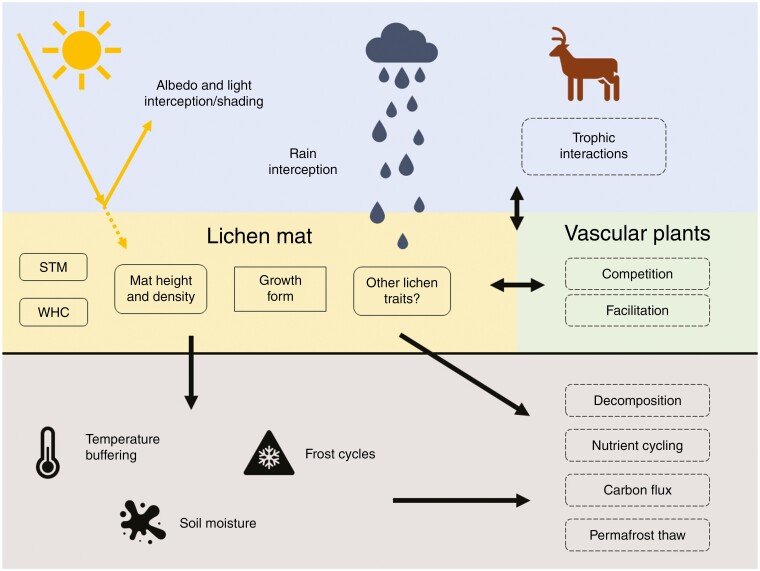Abstract
This article comments on:
Max Mallen-Cooper, Bente J. Graae and Will K. Cornwell. Lichens buffer tundra microclimate more than the expanding shrub Betula nana, Annals of Botany, Volume 128, Issue 4, 3 September 2021, Pages 407–418, https://doi.org/10.1093/aob/mcab041
Keywords: Lichen traits, Betula nana, climate change
Lichens are a fascinating life-form and the outcome of a symbiotic relationship between a fungal and a photosynthetic partner, usually a green alga but in some species cyanobacteria. Lichens are found in virtually any terrestrial ecosystem and their presence is particularly striking in tundra and boreal ecosystems where they constitute a major component of the ground-covering vegetation (Fig. 1). Although lichen diversity and their ecological importance have long been recognized, lichens and other non-vascular primary producers have recently gained attention from a functional traits perspective. As such, lichen traits respond to but can simultaneously affect the environment they live in. In the current issue of Annals of Botany, Mallen-Cooper et al. (2021) describe how 13 different species and mixtures of alpine ground-dwelling lichens affect soil microclimate. They show that lichens buffer against extreme temperatures and, unexpectedly, that they reduce soil moisture by absorbing rainfall events. The lichens affected soil microclimate more so than a common alpine deciduous shrub, Betula nana, which is expected to expand its cover in response to ongoing climate change.
Fig. 1.
In the Alpine region, ground-dwelling lichens form extensive mats and impact at a landscape scale, as seen here in Forrolhogna National Park, Norway, at approximately 1100 m a.s.l. and 90 km northeast of the study site used by Mallen-Cooper et al. (2021). The white-yellowish colours indicate where Cladonia spp. and Flavocetraria nivalis dominate the vegetation. Photo: Ruben Erik Roos.
Because lichens come in many different forms, their impacts on ecosystems and ecological communities vary (Asplund and Wardle, 2017). However, one common characteristic that separates all lichens from vascular plants is that they lack specialized physiological structures (e.g. roots, phloem, xylem) to maintain homeostasis. As a result, lichens are only photosynthetically active when their moisture status allows them to be, and moisture status in turn depends on the prevailing environmental conditions but is also affected by their morphological characteristics. Given their abundance and presence in almost any terrestrial ecosystem, there is a pressing need to develop a ‘Lichen Functional Framework’ that incorporates their unique set of response and effect traits in a framework analogous to those developed for vascular plants.
A first coherent attempt towards such a framework for non-vascular primary producers was presented in Annals of Botany by Cornelissen et al. (2007) and recently refined for lichens by Ellis et al. (2021). In their review, Ellis et al. (2021) proposed that traits related to how lichens respond to water availability also function as effect traits by regulating how lichens impact on the subsurface energy balance and microclimate. Examples of such traits are the (correlated) specific thallus mass, water-holding capacity, size/mat height and growth form. The distribution of these lichen traits across and within ecosystems is directly linked to the hydration sources available to the lichens, such as rain, dew or humid air (Gauslaa, 2014). In this regard, Mallen-Cooper et al. (2021) confirm that specific thallus mass plays a role in the ability of lichens to retain water. However, water-holding capacity was unrelated to temperature effects. As indicated by the authors, this contrasts with earlier studies such as by Van Zuijlen et al. (2020), in which lichen traits were measured on intact lichen mats instead of on collections of lichen thalli such as by Mallen-Cooper et al. (2021).
These seemingly subtle differences in methodological approach between studies are indicative of an ongoing debate among functional ecologists and lichenologists on which level to measure lichen traits: the individual lichen thallus, or the intact lichen mat as found in the natural ecosystem. While thallus-level trait measurements are likely to provide better insight into physiological processes and how lichen traits respond to their environment, they do not necessarily directly apply to the dense, often mixed-species mats many ground-dwelling lichen species form in the field. As such, Ellis et al. (2021) note that traits measured at the level of a community or population, such as lichen mats, are probably more relevant to regulating ecosystem processes than the variability of individual thalli. This highlights the need for a coordinated effort to formulate guidelines for ecologists aiming to understand which lichen traits are important at which scale, by using standardized trait protocols such as those available for vascular plants, invertebrates and biological crusts, among others (Mallen-Cooper et al., 2020).
Even though the microclimatic buffering effects of lichens reported by Mallen-Cooper et al. (2021) are based on a relatively short time span, they find support from other studies performed over longer durations (e.g. Nystuen et al., 2019; Van Zuijlen et al., 2020), which additionally showed that lichens reduce the frequency of freeze–thaw cycles (Van Zuijlen et al., 2020). Consequently, lichen mats can impact on geophysical processes, biotic interactions and ecosystem processes (Fig. 2). For example, lichens protect against permafrost thaw (Porada et al., 2016), and lichen-dominated landscapes have a relatively high surface albedo compared to those dominated by vascular plants (Aartsma et al., 2020). Furthermore, lichens may protect organisms living within and underneath the lichens from climatic extremes and thereby modulate biotic interactions. As such, Nystuen et al. (2019) provided interesting insight into how the facilitating properties of lichen mats outweigh competitive and allelopathic effects on seedling recruitment. Finally, Van Zuijlen et al. (2020) found that although litter decomposition rates differed underneath mats of different lichen species, these patterns did not correspond to the lichens’ effect on microclimate and the measured lichen traits. To date, however, we do not fully understand how lichen mats affect decomposition rates and the assembly of the decomposer community.
Fig. 2.
A schematic representation of the ecological interactions involving ground-dwelling mat-forming lichens. Lichen mats reflect more light (albedo) than vascular plants and shade the ground. They also intercept and absorb rainfall. Several lichen traits are key drivers of these processes: specific thallus mass (STM), water-holding capacity (WHC), mat height and density, lichen growth form, and potentially, other unexplored lichen traits. Here, rounded boxes depict continuous traits, while square boxes indicate categorical traits. These traits determine how mat-forming lichens affect soil microclimate, i.e. they buffer temperature, reduce the number of frost cycles and modulate soil moisture. Lichen traits can both directly and indirectly (through soil microclimate) affect ecological processes (dashed boxes), although we know relatively little about the exact mechanisms behind these effects. Furthermore, lichens engage in biotic interactions with vascular plants (competition, facilitation), and higher trophic levels (e.g. reindeer grazing).
The findings of Mallen-Cooper et al. (2021) are particularly timely and relevant as the amplified effects of global warming in the alpine region and Arctic have begun to manifest over recent decades (Box et al., 2019). In response to a warmer climate, lichens generally tend to decrease as they are outcompeted by shrubs and other vascular plants. As the authors point out, lichens will continue to have a strong effect on microclimate until they are fully excluded, and we agree that such a full exclusion of lichens would certainly mark a tipping point in the ecosystem. However, it is likely that variation in microtopography and the resulting climatic conditions at the landscape scale will at least partially safeguard lichens from complete disappearance in the foreseeable future. For example, wind-exposed and well-drained ridges will remain wind-exposed also in future climates and therefore too barren for shrubs to establish, allowing lichens to persist. In addition, the absorption of light rainfall reported by Mallen-Cooper et al. (2021) provides an interesting mechanism by which lichens may be able to compete with vascular plants – at least in relatively dry climates. In conclusion, the results reported by Mallen-Cooper et al. (2021) illustrate the important role lichens play as modulators of soil microclimate in areas where they form dense mats, such as the alpine region and Arctic. More research is needed to understand which lichen effects traits drive microclimatic effects, and how they modulate ecosystem processes and biotic interactions.
LITERATURE CITED
- Aartsma P, Asplund J, Odland A, Reinhardt S, Renssen H. 2020. Surface albedo of alpine lichen heaths and shrub vegetation. Arctic, Antarctic, and Alpine Research 52: 312–322. [Google Scholar]
- Asplund J, Wardle DA. 2017. How lichens impact on terrestrial community and ecosystem properties. Biological Reviews of the Cambridge Philosophical Society 92: 1720–1738. [DOI] [PubMed] [Google Scholar]
- Box, JE, Colgan WT, Christensen TR, et al. . 2019. Key indicators of Arctic climate change: 1971–2017. Environmental Research Letters 14: 045010. [Google Scholar]
- Cornelissen JH, Lang SI, Soudzilovskaia NA, During HJ. 2007. Comparative cryptogam ecology: a review of bryophyte and lichen traits that drive biogeochemistry. Annals of Botany 99: 987–1001. [DOI] [PMC free article] [PubMed] [Google Scholar]
- Ellis CJ, Asplund J, Benesperi R, et al. . 2021. Functional traits in lichen ecology: a review of challenge and opportunity. Microorganisms 9: 766. [DOI] [PMC free article] [PubMed] [Google Scholar]
- Gauslaa Y. 2014. Rain, dew, and humid air as drivers of morphology, function and spatial distribution in epiphytic lichens. The Lichenologist 46: 1–16. [Google Scholar]
- Mallen-Cooper M, Bowker MA, Antoninka AJ, Eldridge D. 2020. A practical guide to measuring functional indicators and traits in biocrusts. Restoration Ecology 28: S56–S66. [Google Scholar]
- Mallen-Cooper M, Graae BJ, Cornwell WK. 2021. Lichens buffer tundra microclimate more than the expanding shrub Betula nana. Annals of Botany 128: 407–418. [DOI] [PMC free article] [PubMed] [Google Scholar]
- Nystuen KO, Sundsdal K, Opedal ØH, Holien H, Strimbeck GR, and Graae BJ. 2019. Lichens facilitate seedling recruitment in alpine heath. Journal of Vegetation Science 30: 868–880. [Google Scholar]
- Porada P, Ekici A, and Beer C. 2016. Effects of bryophyte and lichen cover on permafrost soil temperature at large scale. The Cryosphere 10: 2291–2315. [Google Scholar]
- Van Zuijlen K, Roos RE, Klanderud K, Lang SI, Asplund J. 2020. Mat-forming lichens affect microclimate and decomposition by different mechanisms. Fungal Ecology 44: 100905. [Google Scholar]




